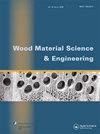火炬松木材高温力学性能的多尺度研究
IF 2.1
3区 农林科学
Q1 MATERIALS SCIENCE, PAPER & WOOD
引用次数: 3
摘要
摘要采用纳米压痕和宏观力学试验机分别研究了木材细胞壁的微观力学和木材在高温下的弯曲性能。用光学显微镜和扫描电镜观察了木材在20 ~ 160℃温度范围内的微观结构。结果表明,温度升高伴随水分释放对木材的力学行为既有细胞壁水平的影响,也有宏观尺度的影响。温度升高至80℃时,细胞壁的弹性模量(E r)和硬度(H)随温度升高而降低,这是由于木质聚合物在湿热条件下的软化。相反,当温度高于100℃时,由于大量的水分释放,E r和H都增加了。在宏观尺度上,厚壁细胞的力学性能的提高对木材弯曲性能的改善起着重要的作用。此外,80℃时的细胞壁具有最高的压痕蠕变比(C IT),即木材在恒定载荷下更容易蠕变。因此,木材在80°C左右的建筑中的机械稳定性应得到更多的关注。本文章由计算机程序翻译,如有差异,请以英文原文为准。
Multi-scale investigation of the mechanical properties of Loblolly pine wood at elevated temperature
ABSTRACT The micromechanics of wood cell walls and the bending properties of wood were investigated by using nanoindentation and macromechanical test machine at elevated temperature, respectively. The microstructure of wood at the temperatures ranged from 20 to 160°C was also observed by optical microscope and scanning electron microscope. Results indicated that the increased temperature accompanying with the moisture release affected the mechanical behavior of wood on both cell-wall level and macroscale. The cell wall’s elastic modulus (E r) and hardness (H) decreased as temperature increased to 80°C due to the softening of wood polymers under hot and humid condition. On the contrary, both the E r and H increased when the temperature was above 100°C ascribed to the massive release of moisture. The increased mechanical properties of the thick-wall cells made a major contribution to the improved bending properties of wood at the macroscale. Furthermore, the cell walls at 80°C own the highest indentation creep ratio (C IT), that is, wood are easier to creep under a constant load. In hence, the mechanical stability of timber in constructions at about 80°C shall be paid more attention.
求助全文
通过发布文献求助,成功后即可免费获取论文全文。
去求助
来源期刊

Wood Material Science & Engineering
Materials Science-General Materials Science
CiteScore
3.90
自引率
13.60%
发文量
131
审稿时长
79 days
期刊介绍:
Wood Material Science and Engineering is a multidisciplinary and international journal with the aim to serve at the forefront of the wood science and technology field. The journal publishes original articles on basic and applied research dealing with:
-Wood material science with emphasis on: water-wood relations, wood durability, wood modification, wood mechanics, wood composites, engineered wood products, energy conversion and eco-efficient wood based products.
-Wood engineering, i.e. the application of the wood material science to designing, processing and manufacturing of forest products and the use of machines and processes for these products. Products of concern are biofuels, sawn wood and further refined products such as structural elements, interior fittings and furnishings. In this aspect the link between the nature of the wood material and the properties of the final wood products in-service and its impact on the environment is of outmost importance.
High quality review papers may also be accepted but the topic should be discussed with the editor before submission.
 求助内容:
求助内容: 应助结果提醒方式:
应助结果提醒方式:


